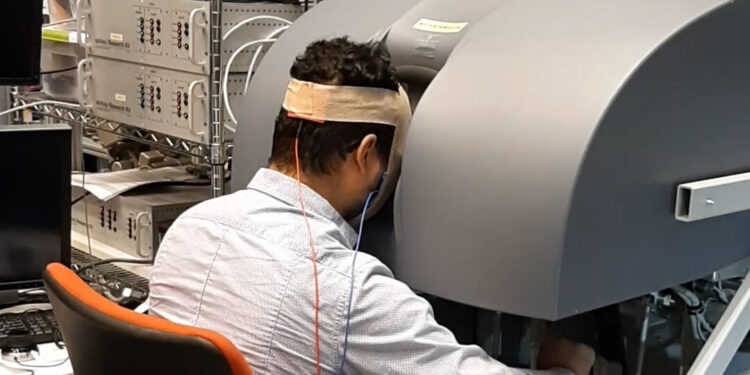A study participant undergoing non-invasive brain stimulation sits in front of the surgical robot console using virtual reality simulations of needle driving exercises. Credit: Guido Caccianiga/Johns Hopkins University.
People who received gentle electrical currents to the back of their heads learned to maneuver a robotic surgery tool in virtual reality and then in a real environment much more easily than people who did not receive these nudges, shows a new study.
The findings offer a first look at how stimulating a specific part of the brain called the cerebellum could help medical professionals apply what they learn in virtual reality in real operating rooms, a much-needed transition in a field that increasingly relies on digital simulation training. , said Johns Hopkins University author and roboticist Jeremy D. Brown.
“Training in virtual reality is not the same as training in a real-world environment, and we have shown with previous research that it can be difficult to transfer a skill learned in a simulation to the real world” , said Brown, managing director of the John C. Malone Associate Professor of Mechanical Engineering. “It is very difficult to claim statistical accuracy, but we concluded that the people in the study were able to transfer their skills from virtual reality to the real world much more easily when they had this stimulation.”
The work appears today in Scientific reports.
Participants passed a surgical needle through three small holes, first in a virtual simulation and then in a real-world scenario, using the da Vinci Research Kit, an open-source research robot. The exercises mimic the movements needed during surgical procedures on the organs of the stomach, the researchers said.
Participants received a subtle flow of electricity via electrodes or small pads placed on their scalp intended to stimulate the cerebellum of their brain. While half of the group received a constant electrical flow throughout the test, the rest of the participants received only brief stimulation at the beginning and nothing at all for the rest of the tests.
People who received the constant currents showed a noticeable increase in their dexterity. None of them had received prior training in surgery or robotics.
“The group that did not receive stimulation had a little more difficulty applying the skills learned in virtual reality to the real robot, especially the more complex movements involving rapid movements,” said Guido Caccianiga, a former roboticist from Johns Hopkins, now at Max. Planck Institute for Intelligent Systems, which designed and directed the experiments. “The groups that received brain stimulation were better at these tasks.”
Non-invasive brain stimulation is a way to influence parts of the brain from outside the body, and scientists have shown how it can benefit motor learning in rehabilitation therapy, the researchers said. With their work, the team is taking research to a new level by testing how brain stimulation can help surgeons learn skills they might need in real-world situations, said co-author Gabriela Cantarero, former assistant professor of physical medicine and rehabilitation. at Johns Hopkins.
“It was really cool to be able to influence behavior using this setup, where we could really quantify every little aspect of people’s movements, deviations and errors,” Cantarero said.
Robotic surgery systems provide significant benefits to clinicians by enhancing human skills. They can help surgeons minimize hand tremor and perform fine, precise tasks with improved vision.
In addition to influencing how surgeons of the future might learn new skills, this type of brain stimulation also holds promise for skill acquisition in other industries that rely on virtual reality training, including in the field of robotics.
Even outside of virtual reality, stimulation can likely help people learn more generally, the researchers said.
“What if we could show that with brain stimulation, we can learn new skills in half the time?” » said Caccianiga. “That’s a huge margin on cost because you would train people faster; you could save a lot of resources to train more surgeons or engineers who will use these technologies frequently in the future.”
Other authors include Ronan A. Mooney of the Johns Hopkins University School of Medicine and Pablo A. Celnik of the Shirley Ryan AbilityLab.
More information:
Anodal cerebellar t-DCS impacts learning and skill transfer during a robotic surgery training task, Scientific reports (2023).
Provided by Johns Hopkins University
Quote: An electric boost to the head could help doctors operate a surgical robot, new research suggests (December 20, 2023) retrieved December 20, 2023 from
This document is subject to copyright. Apart from fair use for private study or research purposes, no part may be reproduced without written permission. The content is provided for information only.



